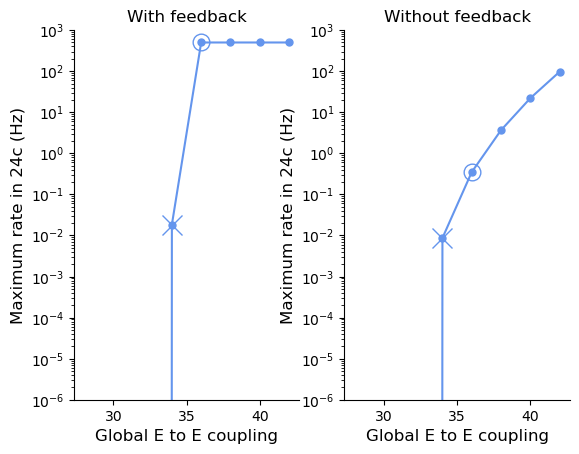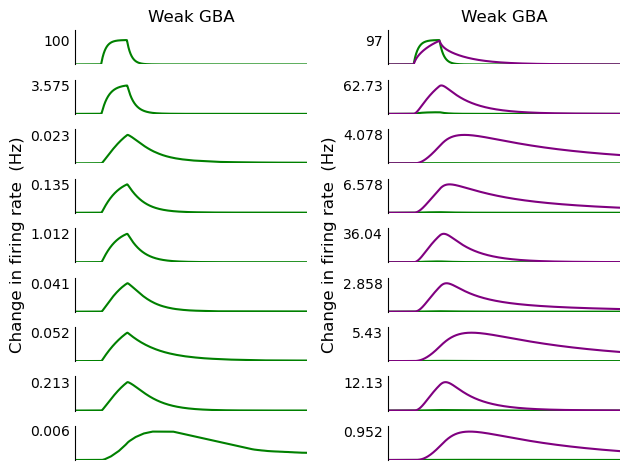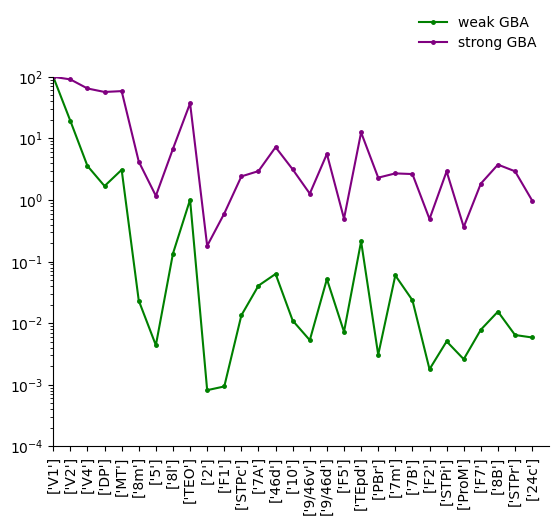(Joglekar, et. al, 2018): Inter-areal Balanced Amplification Figure 2
Implementation of the figure 2 of:
Joglekar, Madhura R., et al. “Inter-areal balanced amplification enhances signal propagation in a large-scale circuit model of the primate cortex.” Neuron 98.1 (2018): 222-234.
[18]:
import brainpy as bp
import brainpy.math as bm
import matplotlib.pyplot as plt
import numpy as np
from jax import vmap, jit
from scipy import io as sio
from functools import partial
[19]:
bm.set_dt(dt=2e-4)
[35]:
bp.__version__
[35]:
'2.4.3'
[20]:
class ThreshLinearModel(bp.NeuGroup):
def __init__(
self,
size, hier, fln, inp_idx, inp_data,
eta=.68, betaE=.066, betaI=.351, tauE=2e-2, tauI=1e-2,
omegaEE=24.3, omegaEI=19.7, omegaIE=12.2, omegaII=12.5,
muIE=25.3, muEE=28., noiseE=None, noiseI=None, seed=None,
desired_ss=None, name=None
):
super(ThreshLinearModel, self).__init__(size, name=name)
# parameters
self.hier = hier
self.fln = fln
self.eta = bp.init.parameter(eta, self.num, False)
self.betaE = bp.init.parameter(betaE, self.num, False)
self.betaI = bp.init.parameter(betaI, self.num, False)
self.tauE = bp.init.parameter(tauE, self.num, False)
self.tauI = bp.init.parameter(tauI, self.num, False)
self.omegaEE = bp.init.parameter(omegaEE, self.num, False)
self.omegaEI = bp.init.parameter(omegaEI, self.num, False)
self.omegaIE = bp.init.parameter(omegaIE, self.num, False)
self.omegaII = bp.init.parameter(omegaII, self.num, False)
self.muIE = bp.init.parameter(muIE, self.num, False)
self.muEE = bp.init.parameter(muEE, self.num, False)
self.desired_ss = desired_ss
self.seed = seed
self.noiseE = bp.init.parameter(noiseE, self.num, True)
self.noiseI = bp.init.parameter(noiseI, self.num, True)
self.inp_idx, self.inp_data = inp_idx, inp_data
# Synaptic weights for intra-areal connections
self.wEE_intra = betaE * omegaEE * (1 + eta * hier)
self.wIE_intra = betaI * omegaIE * (1 + eta * hier)
self.wEI_intra = -betaE * omegaEI
self.wII_intra = -betaI * omegaII
# Synaptic weights for inter-areal connections
self.wEE_inter = bm.asarray(fln.T * (betaE * muEE * (1 + eta * hier))).T
self.wIE_inter = bm.asarray(fln.T * (betaI * muIE * (1 + eta * hier))).T
# Variables
self.re = bm.Variable(bm.zeros(self.num))
self.ri = bm.Variable(bm.zeros(self.num))
# get background input
if desired_ss is None:
self.bgE = bm.zeros(self.num)
self.bgI = bm.zeros(self.num)
else:
if len(desired_ss) != 2:
raise ValueError
if len(desired_ss[0]) != self.num:
raise ValueError
if len(desired_ss[1]) != self.num:
raise ValueError
self.bgE, self.bgI = self.get_background_current(*desired_ss)
def get_background_current(self, ssE, ssI):
# total weights
wEEaux = bm.diag(-1 + self.wEE_intra) + self.wEE_inter
wEIaux = self.wEI_intra * bm.eye(self.num)
wIEaux = bm.diag(self.wIE_intra) + self.wIE_inter
wIIaux = (-1 + self.wII_intra) * bm.eye(self.num)
# temp matrices to create matrix A
A1 = bm.concatenate((wEEaux, wEIaux), axis=1)
A2 = bm.concatenate((wIEaux, wIIaux), axis=1)
A = bm.concatenate([A1, A2])
ss = bm.concatenate((ssE, ssI))
cur = -bm.dot(A, ss)
self.re.value, self.ri.value = ssE, ssI
# state = bm.linalg.lstsq(-A, cur, rcond=None)[0]
# self.re.value, self.ri.value = bm.split(state, 2)
return bm.split(cur, 2)
def reset(self):
if self.desired_ss is None:
self.re[:] = 0.
self.ri[:] = 0.
else:
self.re.value = self.desired_ss[0]
self.ri.value = self.desired_ss[1]
def update(self):
tdi = bp.share.get_shargs()
# E population
Ie = bm.dot(self.wEE_inter, self.re) + self.wEE_intra * self.re
Ie += self.wEI_intra * self.ri + self.bgE
if self.noiseE is not None:
Ie += self.noiseE * bm.random.randn(self.num) / bm.sqrt(tdi.dt)
Ie[self.inp_idx] += self.inp_data[tdi['i']]
self.re.value = bm.maximum(self.re + (-self.re + bm.maximum(Ie, 10.)) / self.tauE * tdi.dt, 0)
# I population
Ii = bm.dot(self.wIE_inter, self.re) + self.wIE_intra * self.re
Ii += self.wII_intra * self.ri + self.bgI
if self.noiseI is not None:
Ii += self.noiseI * bm.random.randn(self.num) / bm.sqrt(tdi.dt)
self.ri.value = bm.maximum(self.ri + (-self.ri + bm.maximum(Ii, 35.)) / self.tauI * tdi.dt, 0)
[21]:
def simulate(num_node, muEE, fln, hier, input4v1, duration):
model = ThreshLinearModel(int(num_node),
hier=hier, fln=fln,
inp_idx=0, inp_data=input4v1, muEE=muEE,
desired_ss=(bm.ones(num_node) * 10, bm.ones(num_node) * 35))
runner = bp.DSRunner(model, monitors=['re'], progress_bar=False, numpy_mon_after_run=False)
runner.run(duration)
return runner.mon.ts, runner.mon.re
[22]:
def show_firing_rates(ax, hist_t, hist_re, show_duration=None, title=None):
hist_t = bm.as_numpy(hist_t)
hist_re = bm.as_numpy(hist_re)
if show_duration is None:
i_start, i_end = (1.75, 5.)
else:
i_start, i_end = show_duration
i_start = round(i_start / bm.get_dt())
i_end = round(i_end / bm.get_dt())
# visualization
rateV1 = np.maximum(1e-2, hist_re[i_start:i_end, 0] - hist_re[i_start, 0])
rate24 = np.maximum(1e-2, hist_re[i_start:i_end, -1] - hist_re[i_start, -1])
ax.semilogy(hist_t[i_start:i_end], rateV1, 'dodgerblue')
ax.semilogy(hist_t[i_start:i_end], rate24, 'forestgreen')
ax.set_ylim([1e-2, 1e2 + 100])
# ax.set_xlim([-0.25, 2.25])
ax.spines['top'].set_visible(False)
ax.spines['right'].set_visible(False)
ax.set_ylabel('Change in firing rate (Hz)', fontsize='large')
ax.set_xlabel('Time (s)', fontsize='large')
if title:
ax.set_title(title)
[23]:
def show_maximum_rate(ax, muEE_range, peak_rates, title=''):
ax.semilogy(muEE_range[4], np.squeeze(peak_rates[4]), 'cornflowerblue', marker="o",
markersize=12, markerfacecolor='w')
ax.semilogy(muEE_range, np.squeeze(peak_rates), 'cornflowerblue', marker=".", markersize=10)
ax.semilogy(muEE_range[3], np.squeeze(peak_rates[3]), 'cornflowerblue', marker="x", markersize=15)
ax.spines['top'].set_visible(False)
ax.spines['right'].set_visible(False)
ax.set_ylim([1e-6, 1e3])
ax.set_ylabel('Maximum rate in 24c (Hz)', fontsize='large')
ax.set_xlabel('Global E to E coupling', fontsize='large')
if title:
ax.set_title(title)
[24]:
def figure2B():
# data
data = sio.loadmat('Joglekar_2018_data/subgraphData.mat')
num_node = data['nNodes'][0, 0]
hier = bm.asarray(data['hierVals'].squeeze() / max(data['hierVals'])) # normalize hierarchical position
fln = bm.asarray(data['flnMat'])
# inputs
ampl = 21.8 * 1.9
inputs, duration = bp.inputs.section_input([0, ampl, 0], [2., 0.25, 7.75], return_length=True)
# Fig 2B
ax = plt.subplot(1, 2, 1)
times, res = simulate(int(num_node), fln=fln, hier=hier, muEE=34, input4v1=inputs, duration=duration)
show_firing_rates(ax, hist_t=times, hist_re=res, show_duration=(1.75, 5.), title=r'$\mu$EE=34')
ax = plt.subplot(1, 2, 2)
times, res = simulate(int(num_node), fln=fln, hier=hier, muEE=36, input4v1=inputs, duration=duration)
show_firing_rates(ax, hist_t=times, hist_re=res, show_duration=(1.75, 5.), title=r'$\mu$EE=36')
plt.show()
[25]:
figure2B()

[26]:
def figure2C():
# data
data = sio.loadmat('Joglekar_2018_data/subgraphData.mat')
hier = bm.asarray(data['hierVals'].squeeze() / max(data['hierVals'])) # normalize hierarchical position
fln = bm.asarray(data['flnMat'])
# inputs
ampl = 21.8 * 1.9
inputs, duration = bp.inputs.section_input([0, ampl, 0], [2., 0.25, 7.75], return_length=True)
all_muEE = bm.arange(28, 44, 2)
i_start, i_end = (round(1.75 / bm.get_dt()), round(5. / bm.get_dt()))
@jit
@partial(vmap, in_axes=(0, None))
def peak_firing_rate(muEE, fln):
_, res = simulate(fln.shape[0], fln=fln, hier=hier, muEE=muEE,
input4v1=inputs, duration=duration)
return (res[i_start:i_end, -1] - res[i_start, -1]).max()
# with feedback
ax = plt.subplot(1, 2, 1)
area2peak = peak_firing_rate(all_muEE, fln)
area2peak = bm.where(area2peak > 500, 500, area2peak)
show_maximum_rate(ax, all_muEE.to_numpy(), area2peak.to_numpy(), title='With feedback')
# without feedback
ax = plt.subplot(1, 2, 2)
area2peak = peak_firing_rate(all_muEE, bm.tril(fln))
area2peak = bm.where(area2peak > 500, 500, area2peak)
show_maximum_rate(ax, all_muEE.to_numpy(), area2peak.to_numpy(), title='Without feedback')
plt.show()
[27]:
figure2C()

[28]:
sStrong = 1000
sWeak = 100
def show_multiple_area_rates(axes, times, rates, plot_duration, color='green'):
t_start, t_end = plot_duration
i_start, i_end = round(t_start / bm.get_dt()), round(t_end / bm.get_dt())
areas2plot = [0, 2, 5, 7, 8, 12, 16, 18, 28]
for i, j in enumerate(areas2plot):
ax = axes[i]
ax.plot(times[i_start:i_end] - 100, rates[i_start:i_end, j] - rates[i_start, j], color)
ax.set_xlim([-98.25, -96])
ax.spines['top'].set_visible(False)
ax.spines['right'].set_visible(False)
ax.spines['bottom'].set_visible(False)
plt.setp(ax.get_xticklabels(), visible=False)
ax.tick_params(axis='both', which='both', length=0)
peak = (rates[i_start:i_end, j] - rates[i_start, j]).max()
if j == 0:
ax.set_ylim([0, 140])
ax.set_yticks([round(sWeak * peak, 1) / sWeak])
ax.set_title('Weak GBA')
else:
ax.set_ylim([0, 1.2 * peak])
ax.set_yticks([round(sWeak * peak, 1) / sWeak])
if i == 4:
ax.set_ylabel('Change in firing rate (Hz)', fontsize='large')
[29]:
def figure3BD():
# data
data = sio.loadmat('Joglekar_2018_data/subgraphData.mat')
hier = bm.asarray(data['hierVals'].squeeze() / max(data['hierVals']))
fln = bm.asarray(data['flnMat'])
num_node = fln.shape[0]
fig, axes = plt.subplots(9, 2)
# weak GBA
muEE = 33.7
omegaEI = 19.7
ampl = 22.05 * 1.9
inputs, duration = bp.inputs.section_input([0, ampl, 0], [2., 0.25, 7.75], return_length=True)
model = ThreshLinearModel(fln.shape[0],
hier=hier, fln=fln, inp_idx=0, inp_data=inputs,
muEE=muEE, omegaEI=omegaEI,
desired_ss=(bm.ones(num_node) * 10, bm.ones(num_node) * 35))
runner1 = bp.DSRunner(model, monitors=['re'], )
runner1.run(duration)
show_multiple_area_rates(times=runner1.mon.ts,
rates=runner1.mon.re,
plot_duration=(1.25, 5.),
axes=[axis[0] for axis in axes])
# strong GBA
muEE = 51.5
omegaEI = 25.2
ampl = 11.54 * 1.9
inputs, duration = bp.inputs.section_input([0, ampl, 0], [2., 0.25, 7.75], return_length=True)
model = ThreshLinearModel(fln.shape[0],
hier=hier, fln=fln, inp_idx=0, inp_data=inputs,
muEE=muEE, omegaEI=omegaEI,
desired_ss=(bm.ones(num_node) * 10, bm.ones(num_node) * 35))
runner2 = bp.DSRunner(model, monitors=['re'], )
runner2.run(duration)
show_multiple_area_rates(times=runner1.mon.ts,
rates=runner1.mon.re,
plot_duration=(1.75, 5.),
axes=[axis[1] for axis in axes],
color='green')
show_multiple_area_rates(times=runner2.mon.ts,
rates=runner2.mon.re,
plot_duration=(1.75, 5.),
axes=[axis[1] for axis in axes],
color='purple')
plt.tight_layout()
plt.show()
[30]:
figure3BD()

[31]:
def figure3E():
# data
data = sio.loadmat('Joglekar_2018_data/subgraphData.mat')
hier = bm.asarray(data['hierVals'].squeeze() / max(data['hierVals']))
fln = bm.asarray(data['flnMat'])
num_node = fln.shape[0]
i_start, i_end = round(1.75 / bm.get_dt()), round(5. / bm.get_dt())
# weak GBA
muEE = 33.7
omegaEI = 19.7
ampl = 22.05 * 1.9
inputs, duration = bp.inputs.section_input([0, ampl, 0], [2., 0.25, 7.75], return_length=True)
model = ThreshLinearModel(fln.shape[0], hier=hier, fln=fln, inp_idx=0, inp_data=inputs, muEE=muEE,
omegaEI=omegaEI, desired_ss=(bm.ones(num_node) * 10, bm.ones(num_node) * 35))
runner1 = bp.DSRunner(model, monitors=['re'], )
runner1.run(duration)
peak1 = (runner1.mon.re[i_start: i_end] - runner1.mon.re[i_start]).max(axis=0)
# strong GBA
muEE = 51.5
omegaEI = 25.2
ampl = 11.54 * 1.9
inputs, duration = bp.inputs.section_input([0, ampl, 0], [2., 0.25, 7.75], return_length=True)
model = ThreshLinearModel(fln.shape[0], hier=hier, fln=fln, inp_idx=0, inp_data=inputs, muEE=muEE,
omegaEI=omegaEI, desired_ss=(bm.ones(num_node) * 10, bm.ones(num_node) * 35))
runner2 = bp.DSRunner(model, monitors=['re'], )
runner2.run(duration)
peak2 = (runner2.mon.re[i_start: i_end] - runner2.mon.re[i_start]).max(axis=0)
# visualization
fig, ax = plt.subplots()
ax.semilogy(np.arange(0, num_node), 100 * peak1 / peak1[0], 'green', marker=".", markersize=5)
ax.semilogy(np.arange(0, num_node), 100 * peak2 / peak2[0], 'purple', marker=".", markersize=5)
ax.spines['top'].set_visible(False)
ax.spines['right'].set_visible(False)
ax.set_ylim([1e-4, 1e2])
ax.set_xlim([0, num_node])
ax.legend(['weak GBA', 'strong GBA'], prop={'size': 10}, loc='upper right',
bbox_to_anchor=(1.0, 1.2), frameon=False)
ax.set_xticks(np.arange(0, num_node))
ax.set_xticklabels(data['areaList'].squeeze(), rotation='vertical', fontsize=10)
plt.show()
[32]:
figure3E()

[33]:
def figure3F():
# data
data = sio.loadmat('Joglekar_2018_data/subgraphData.mat')
hier = bm.asarray(data['hierVals'].squeeze() / max(data['hierVals']))
fln = bm.asarray(data['flnMat'])
num_node = fln.shape[0]
i_start, i_end = round(1.75 / bm.get_dt()), round(3.5 / bm.get_dt())
# input
ampl = 22.05 * 1.9
inputs, duration = bp.inputs.section_input([0, ampl, 0], [2., 0.25, 7.75], return_length=True)
@partial(vmap, in_axes=(0, None))
def maximum_rate(muEE, omegaEI=None):
if omegaEI is None: omegaEI = 19.7 + (muEE - 33.7) * 55 / 178
model = ThreshLinearModel(num_node, hier=hier, fln=fln, inp_idx=0, inp_data=inputs, muEE=muEE,
omegaEI=omegaEI, desired_ss=(bm.ones(num_node) * 10, bm.ones(num_node) * 35))
runner = bp.DSRunner(model, monitors=['re'], progress_bar=False, numpy_mon_after_run=False)
runner.run(duration)
return (runner.mon.re[i_start: i_end, -1] - runner.mon.re[i_start, -1]).max()
# visualization
muEErange = bm.arange(20, 52, 2)
peaks_with_gba = maximum_rate(muEErange, None)
peaks_without_gba = maximum_rate(muEErange, 19.7)
peaks_with_gba = bm.where(peaks_with_gba > 500, 500, peaks_with_gba)
peaks_without_gba = bm.where(peaks_without_gba > 500, 500, peaks_without_gba)
fig, ax = plt.subplots()
ax.semilogy(muEErange, peaks_without_gba.to_numpy(), 'cornflowerblue', marker=".", markersize=5)
ax.semilogy(muEErange, peaks_with_gba.to_numpy(), 'black', marker=".", markersize=5)
ax.spines['top'].set_visible(False)
ax.spines['right'].set_visible(False)
ax.set_ylim([1e-8, 1e4])
ax.set_xlim([20, 50])
ax.set_ylabel('Maximum rate in 24c (Hz)', fontsize='large')
ax.set_xlabel('Global E to E coupling', fontsize='large')
plt.show()
[34]:
figure3F()

